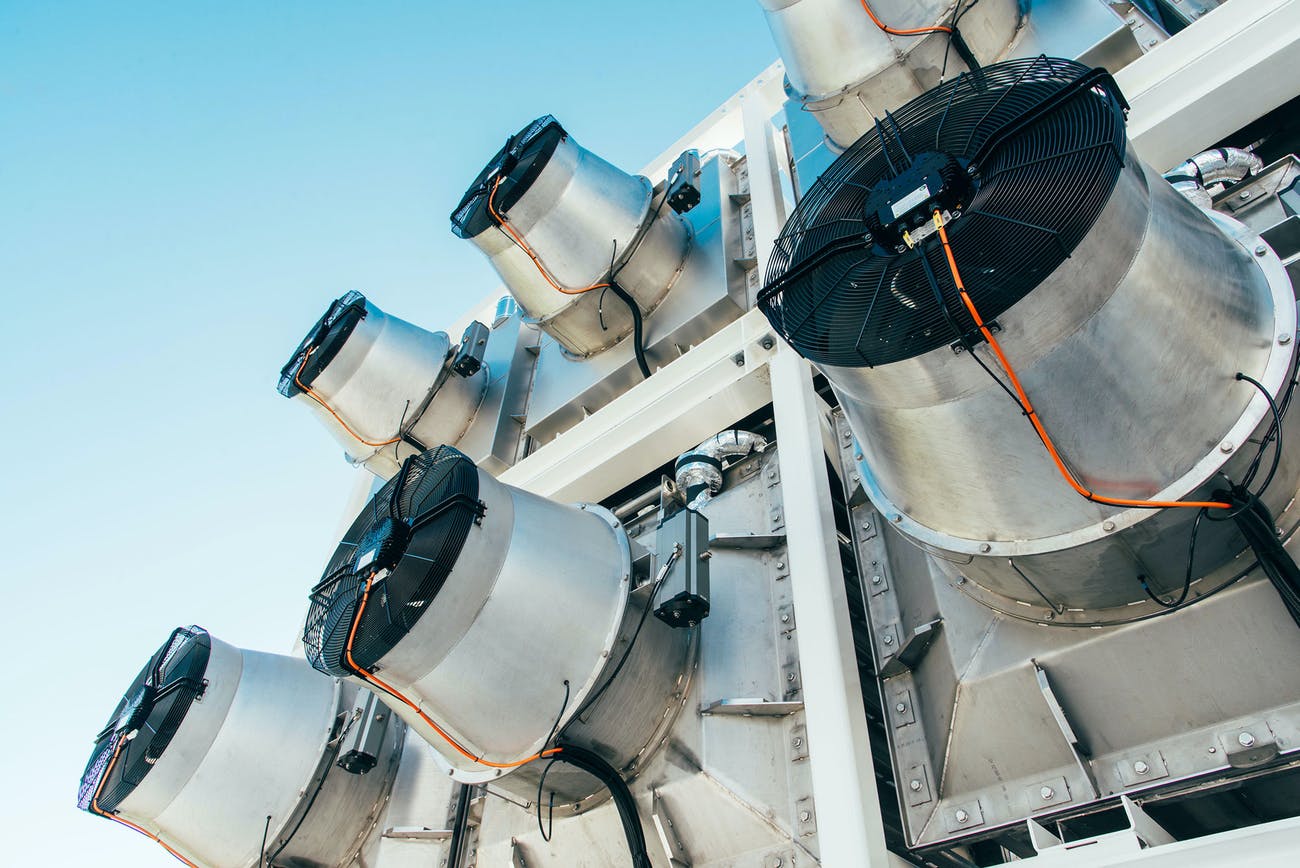
The Coalition for Negative Emissions


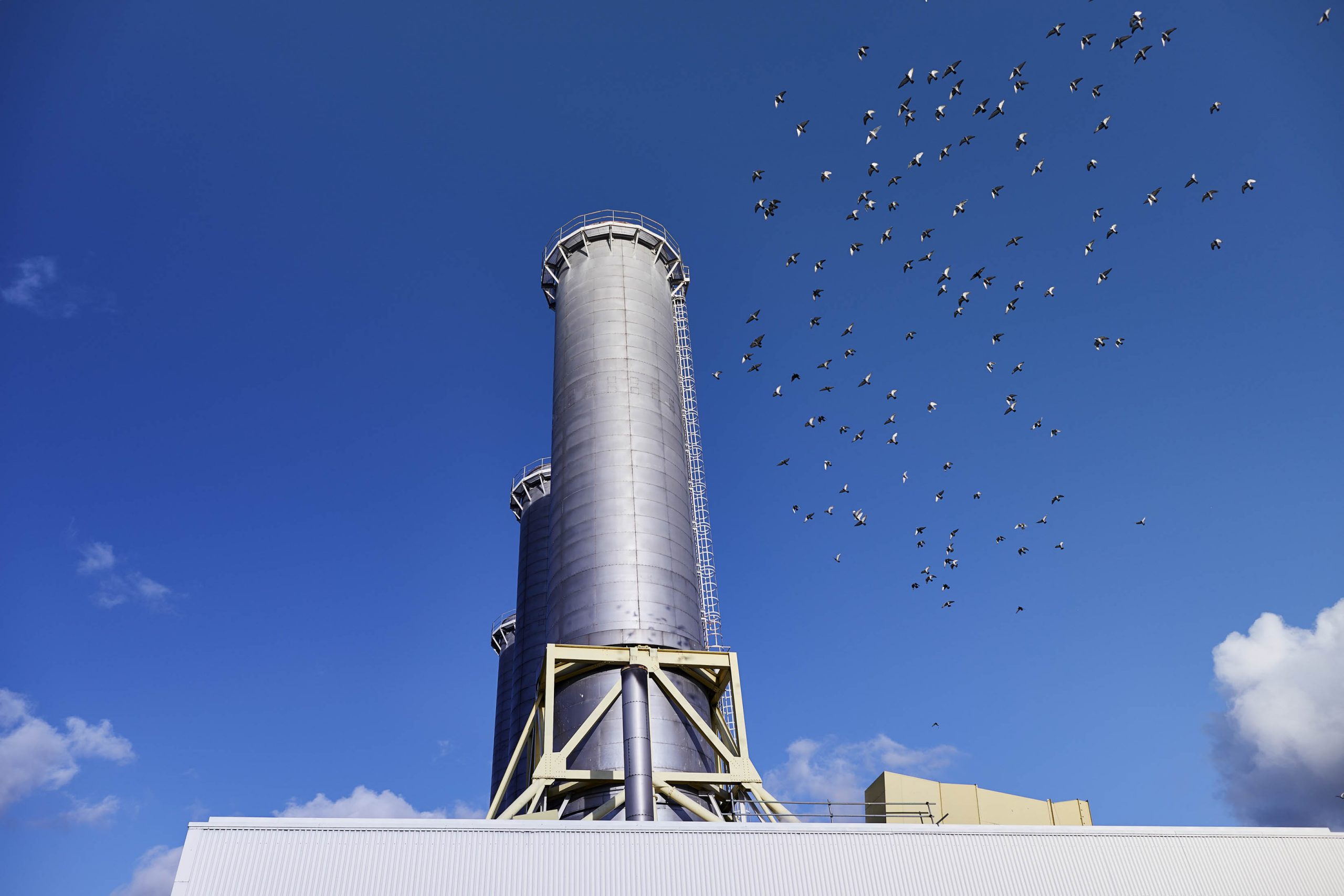
(“Drax”, “the Group”, “Drax Group”, “the Company”; Symbol: DRX)
Drax is pleased to announce that it has reached agreement for the sale of Drax Generation Enterprise Limited (“DGEL”), which holds four Combined Cycle Gas Turbine (“CCGT”) power stations, to VPI Holding Limited (“VPI”) for consideration of £193.3 million, subject to customary adjustments. This includes £29.0 million of contingent consideration associated with the option to develop a new CCGT at Damhead Creek.
The transaction is subject to certain customary closing conditions, including anti-trust approval, with completion to take place by 31 January 2021.
The CCGTs have performed well since acquisition by Drax in December 2018, but do not form part of the Group’s core flexible and renewable generation strategy. Drax expects to realise a premium on sale, use the proceeds to develop its biomass supply chain and accelerate its ambition to become a carbon negative business by 2030.
DGEL also holds the Group’s pumped storage and hydro assets and is the shareholder of SMW Limited (the owner of the Daldowie fuel plant). These assets, shares and employees are to be transferred out of DGEL prior to completion and will be retained by Drax.
“By focusing on our flexible and renewable generation activities in the UK we expect to deliver a further reduction in the Group’s CO2 emissions, which should accelerate our ambition to become not just carbon neutral but carbon negative by 2030.
“By using carbon capture and storage with biomass (BECCS) at the power station in North Yorkshire to underpin the decarbonisation of the wider Humber region, we believe we would be creating and supporting around 50,000 new jobs and delivering a green economic recovery in the North.
“We greatly value the contribution that our colleagues in gas generation have made to the Group over the last two years. As we focus on a renewable and flexible portfolio, it is right that we divest these gas generation assets and in doing so create value for our shareholders.”
Between 2012 and 2019, through investment in sustainable biomass and hydro, Drax has reduced its carbon emissions by over 85% and become the largest source of renewable electricity in the UK(1).
In December 2019 Drax announced an ambition to become a carbon negative company by 2030. The negative emissions provided by BECCS will offset carbon emissions within the Group’s supply chain and help to offset emissions in harder to abate sectors of the economy, such as aviation and agriculture.
In February 2020 Drax announced an end to commercial coal generation in 2021 and now, by divesting its existing gas generation assets, Drax will further reduce its carbon emissions.
Drax will continue to provide system support services alongside its decarbonisation strategy through its renewable generation portfolio, other development opportunities and demand-side response within its Customers business. These activities provide renewable electricity and a fully flexible generation and supply portfolio, which can support the UK power system as it becomes increasingly reliant on intermittent and inflexible generation sources.
Drax acquired the CCGTs from Iberdrola in December 2018 as part of a portfolio of pumped storage, hydro and gas generation. The majority of the value in the acquisition was ascribed to the pumped storage and hydro assets, which in the first six months of 2020 provided £35 million of Adjusted EBITDA(3). In the same period the CCGTs provided £18 million of Adjusted EBITDA. Group Adjusted EBITDA for the first six months of 2020 was £179 million.
As at 30 June 2020 the gross fixed assets for the CCGTs were £182 million.
The CCGTs also have £89 million of Capacity Market income between 2021 and 2024(4) which will remain with DGEL on completion.
The CCGT business currently employs 121 people in operational roles who will transfer with DGEL on completion.
Drax has agreed a series of transitional services to support the transition through 2021.
Drax continues to evaluate options for the development of four Open Cycle Gas Turbines and Drax Power Station following the end of coal operations.
Total consideration is £193.3 million, subject to customary completion accounts adjustments, comprising £164.3 million for the four CCGT power stations and a further £29.0 million of contingent consideration payable on satisfaction of certain triggers in respect of the option to develop a new CCGT at Damhead Creek.
The payment of £164.3 million in respect of the four CCGTs is payable in cash on completion, with an option to defer the payment of £50.0 million until April 2022. The deferred component would carry an interest rate of four percent and be backed by a letter of credit. In the event that the deferral option is exercised Drax intends to convert the payment obligation to cash upon completion for the face value.
Subject to fulfilment of pre-closing conditions, completion is to take place by 31 January 2021.
The sale price represents an expected premium compared to the book value of the assets, subject to customary adjustments and a return over the period of ownership significantly ahead of the Group’s WACC.
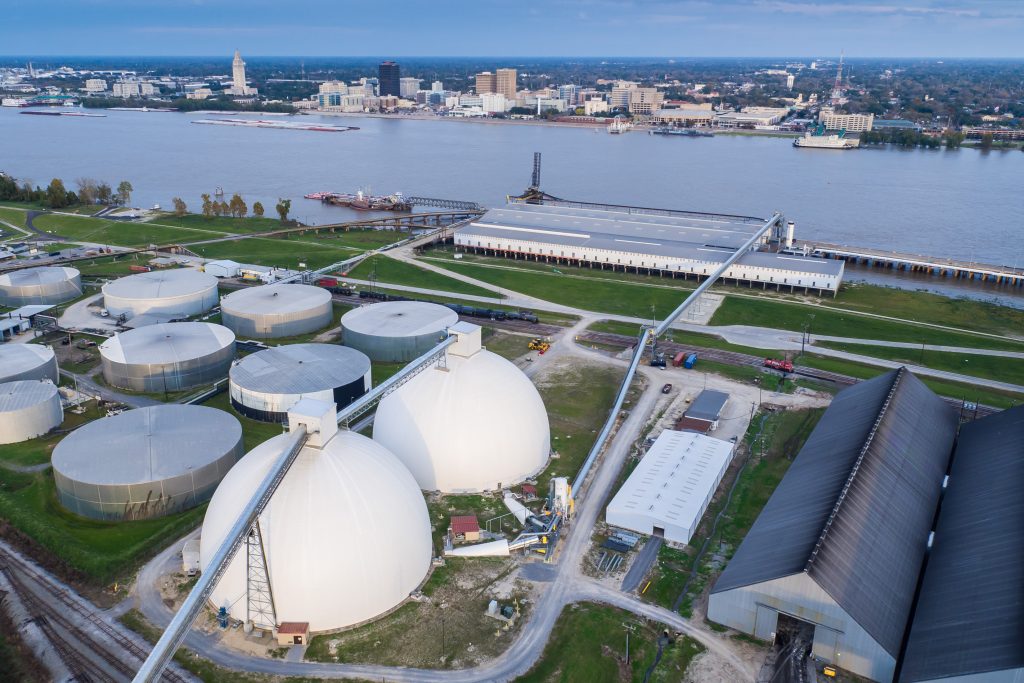
Sustainable biomass wood pellet storage domes at Baton Rouge Transit, a renewable fuel storage and logistics site operated by Drax at the Port of Greater Baton Rouge, Louisiana [Click to view/download]
These savings will be delivered through the optimisation of existing biomass operations, greater utilisation of low-cost wood residues and an expansion of the fuel envelope to incorporate other low-cost renewable biomass across the Group’s expanded supply chain.
Drax believes that the additional capital and operating cost investment required to deliver this supply chain expansion is in the region of £600 million, which the Group expects to invest ahead of 2027. Drax remains alert to sector opportunities for both organic and inorganic growth.
The Group has identified three models through which it believes it can deliver a long-term future for sustainable biomass, all of which are underpinned by the delivery of its supply chain expansion and cost reduction plans. These options, which are not mutually exclusive, are summarised below. The delivery of one or more of these models by 2027 would enable Drax to continue its biomass activities when the current UK renewable schemes for biomass generation end in March 2027.
Drax believe that biomass has an important role to play in the UK as a flexible and reliable source of renewable energy, supporting increased utilisation of intermittent and inflexible generation across the UK power grid. In March 2027, when the current CfD(6) and ROC(7) renewable schemes end, Drax believes that through a combination of peak power generation, system support services, Capacity Market income and a low-cost operating model for Drax Power Station (including low-cost biomass), this site can continue to operate as a merchant renewable power station.
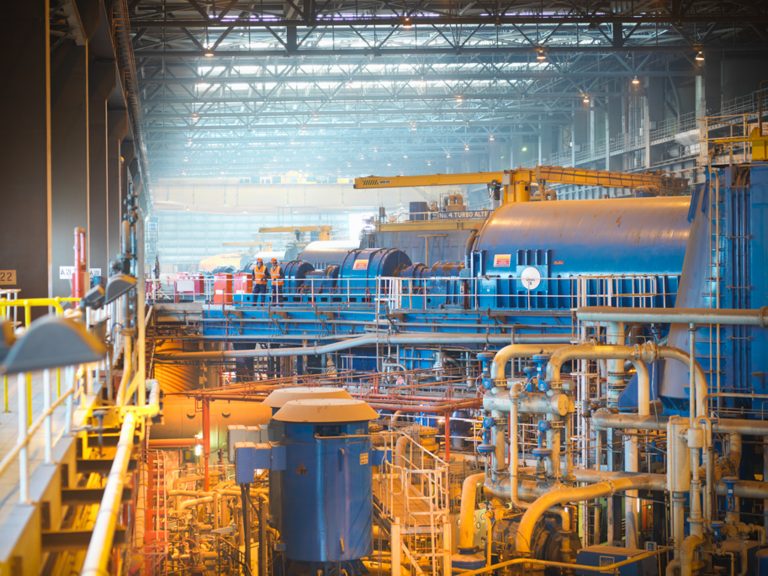
The four biomass units located in the turbine hall at Drax Power Station have a total capacity of 2.6 GW [Click to view/download]
The UK’s Climate Change Committee (CCC) has set out what is required for the country to achieve its legally binding objective of being net zero by 2050. This includes an important role for BECCS to remove CO2 from the atmosphere, creating negative emissions. BECCS is the only large-scale solution for negative emissions with renewable electricity and system support capabilities. Through combining BECCS with its existing four biomass generation units at Drax Power Station, Drax believes it could remove up to 16 million tonnes of CO2 per year – over two thirds of the CCC’s 2035 target for BECCS. In doing so Drax aims to become a carbon negative company by 2030.
The technology to deliver post-combustion BECCS exists and is proven at scale. In September 2020, Drax commenced a trial of one such technology provided by Mitsubishi Heavy Industries (MHI). In addition, Drax is developing innovative technology options, including C-Capture, a partnership between Leeds University, Drax, IP Group and BP, which has developed an organic solvent which could be used for BECCS.
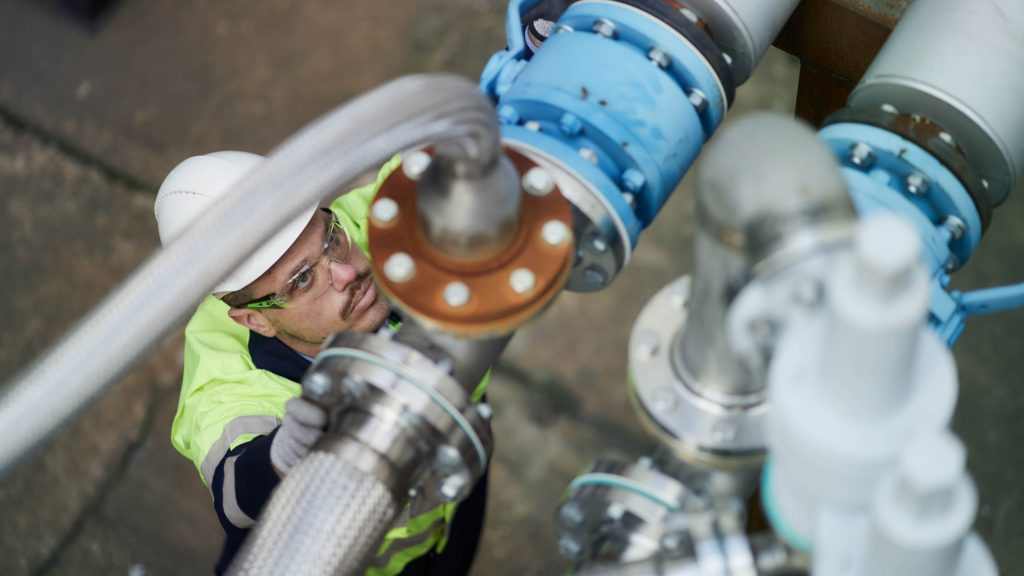
Innovation engineer inspects pilot carbon capture facility at Drax Power Station [Click to view/download]
Drax expects global demand for wood pellets to increase in the current decade, as other countries develop decarbonisation programmes which recognise the benefits of sustainable biomass for generation. Whilst there is an abundance of unprocessed sustainable biomass material globally, there remains limited capacity to convert these materials into energy dense pellets, which have a low-carbon footprint and lower cost associated with transportation. As a result, Drax expects the global market for biomass to remain under supplied. Drax is therefore exploring options to service biomass demand in Europe, North America and Asia alongside the UK. Establishing a presence in these markets could offer the potential for long-term offtake agreements, providing diversified revenues from other biomass markets.
Since publishing its half year results on 29 July 2020 the trading and operational performance of the Group has remained robust.
In the USA, the Group’s Pellet Production business is commissioning 100,000 tonnes of new production capacity at its Morehouse facility in Louisiana as part of its previously announced plans to add 350,000 tonnes across its three existing production sites by 2022. The project is part of the Group’s plan to expand its sustainable biomass supply chain and reduce costs.
The Generation business has continued to perform well in the provision of system support services, responding to both the low and high demand needs of the UK electricity system.
In addition to the successful completion of a major planned outage and upgrade of a biomass unit at Drax Power Station, the Group has progressed its earlier stage development work on BECCS. Alongside the commencement of a solvent trial with MHI, Drax has awarded pre-FEED (Front End Engineering Design) contracts and expects to incur incremental operating costs associated with the development of a full FEED study during 2021.
At its half year results in July 2020 Drax noted that further lockdown measures in the UK in the second half of 2020 could create a small downside risk on the performance of the Customers business, principally in the SME(8) market. Drax is continuing to assess operational and strategic options for this part of the Group.
The Group’s expectations for 2020 Adjusted EBITDA remain in line with market expectations(9), inclusive of the impact of Covid-19, principally in relation to its Customers business. Full year expectations for the Group remain underpinned by good operational availability for the remainder of 2020.
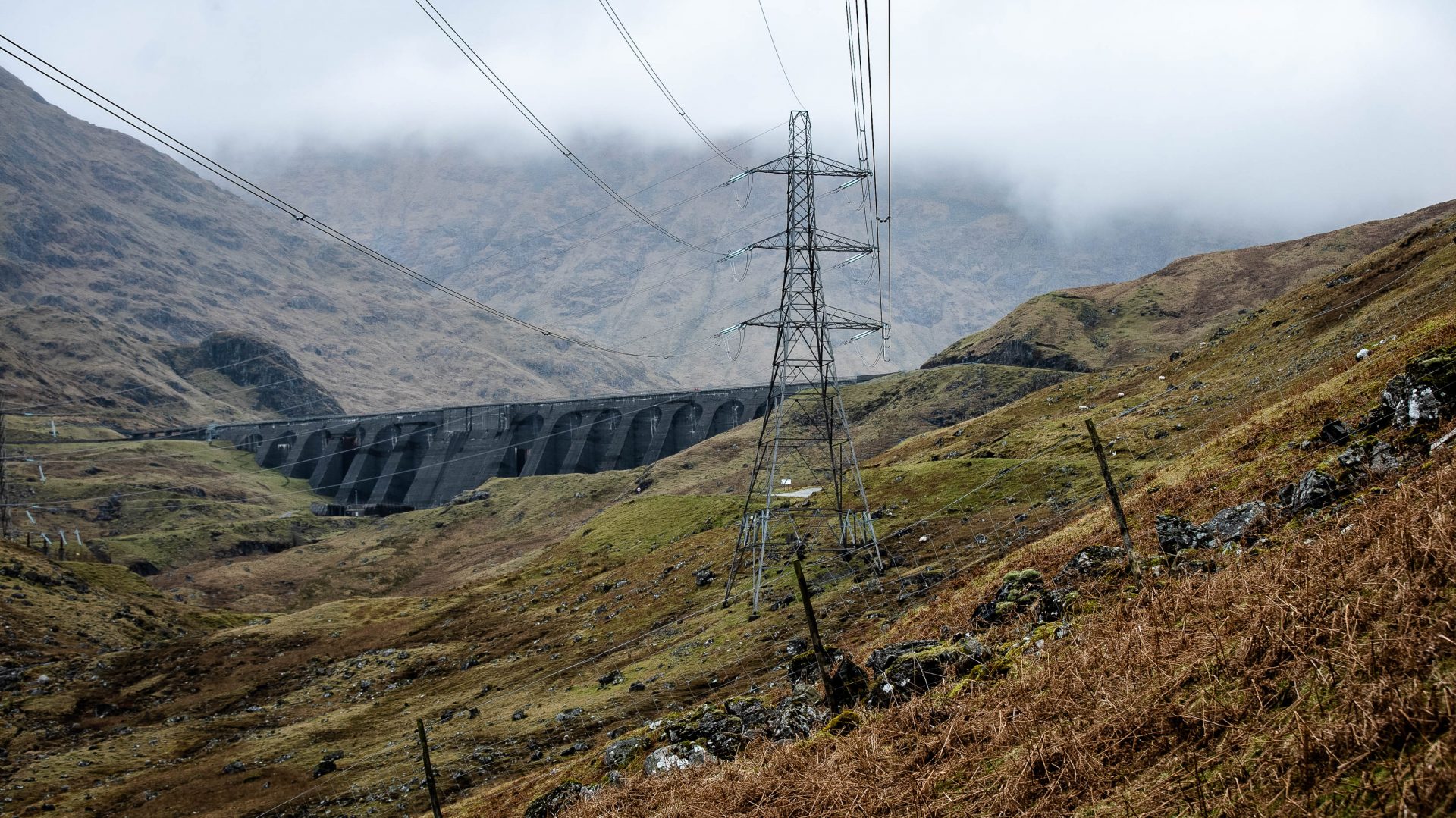
Electricity pylons take flexible power generated from water stored in a reservoir at Cruachan Power Station in the Highlands into the national grid [Click to view/download]
| 2020 | 2021 | 2022 | |
|---|---|---|---|
| Fixed price power sales (TWh) | 18.2 | 15.2 | 6.5 |
| Contracted % versus 2019 full year output | 1.06 | 0.86 | 0.38 |
| Of which CfD (TWh) (10) | 4.8 | 1.7 | - |
| Of which CCGT (TWh) | 2.5 | 3.1 | 0.2 |
| At an average achieved price (£ per MWh) | 54.8 | 48.2 | 48 |
| Average price for CCGT (£ per MWh) | 53.2 | 46.5 | 54.7 |
As announced on 19 November 2020 the Group agreed a new £300 million ESG(11) Revolving Credit Facility (RCF). This replaces an RCF which was due to mature in 2021 and provides increased liquidity, enabling the full facility to be drawn as cash (the previous facility restricted cash drawn to support liquidity to £165 million). The ESG RCF is currently undrawn for cash.
In addition to the ESG RCF, the Group has agreed new infrastructure facilities (£213 million) and a Euro denominated bond issue (€250 million), which replace an existing RCF, Sterling bond and ESG term-loan, reducing the Group’s overall cost of debt and extending its maturity profile to 2030.
As at 30 November 2020 Drax had adjusted cash and total committed facilities of £643 million.
The Group remains committed to its capital allocation policy, through which it aims to maintain a strong balance sheet; invest in the core business; pay a sustainable and growing dividend and return surplus capital beyond investment requirements.
Subject to the continued good operational performance and overall impact from Covid-19 remaining in line with the position Drax set out in April 2020, the Group continues to expect to pay a dividend for the 2020 financial year of 17.1 pence per share (approximately £68 million), a 7.5% increase on 2019. This is consistent with the policy to pay a dividend which is sustainable and expected to grow as the strategy delivers an increasing proportion of stable earnings and cash flows.
Drax Investor Relations:
Mark Strafford
Drax External Communications:
Ali Lewis
Website: www.drax.com
ENDS

December 2020 marks the fifth anniversary of the Paris Agreement. It represented a landmark moment in the global effort to combat climate change and build a better future. However, global progress is not moving at the speed it needs to in order to meet the treaty’s target of keeping global warming below 1.5-2 degrees Celsius.

Explore Carbon Capture by Drax
Countries have set their own decarbonisation targets and many companies have laid out plans to become carbon neutral or even carbon negative – as we at Drax intend to achieve by 2030. While these leading ambitions are important for the UK and the world to meet the goals of the Paris Agreement, real action, polices and investment are needed at scale.
We have a clearer view of the path ahead than five years ago. We know from the recent 6th Carbon Budget that renewable energy, as well as carbon capture, usage and storage (CCUS) are essential for the UK to reach its target of net zero carbon emissions by 2050.
In that detailed, 1,000-page report, the Climate Change Committee (CCC) was clear that progress must be made immediately – the country as a whole must be 78% of the way there by 2035. By investing where it’s needed, the UK can lead the world in a whole new industry. One that may come to define the next century.
It was a combination of resource and ingenuity that enabled the UK to launch the Industrial Revolution some 250 years ago. Today the country is in a similar position of being able to inspire and help transform the world.
As a country – one that I moved to over 20 years ago now – we have decarbonised at a greater pace than any other over the past decade. Investing in renewable generation such as wind, solar and biomass has allowed the UK to transform its energy systems and set ambitious targets for net zero emissions.

To remain resilient and meet the increased electricity demand of the future, power grids will require vastly increased support from energy storage systems such as pumped hydro – as well as flexible, reliable forms of low and zero carbon power generation.
However, the urgency of climate change means the UK must go beyond decarbonisation to implementing negative emissions technologies (which remove more carbon dioxide (CO2) from the atmosphere than they emit). The CCC, as well as National Grid’s Future Energy Scenarios report have emphasised the necessity of negative emissions for the UK to reach net zero, by removing CO2 not just from energy but other industries too.
The UK can build on its global leadership in decarbonisation to invest in the cutting-edge green technology that can take the country to net zero, establishing it as a world leader for others to follow.
When the Paris agreement was signed, I was just joining Drax. I had been impressed by the power station’s transformation from coal to biomass – Europe’s largest decarbonisation project – supporting thousands of jobs in the process.
Five years on and I’m excited for the next stage: delivering negative emissions. By deploying bioenergy with carbon capture and storage (BECCS) we can permanently remove CO2 from the atmosphere while producing renewable electricity.
Drax has successfully piloted BECCS and is ready to deploy it at scale as part of our Zero Carbon Humber partnership.
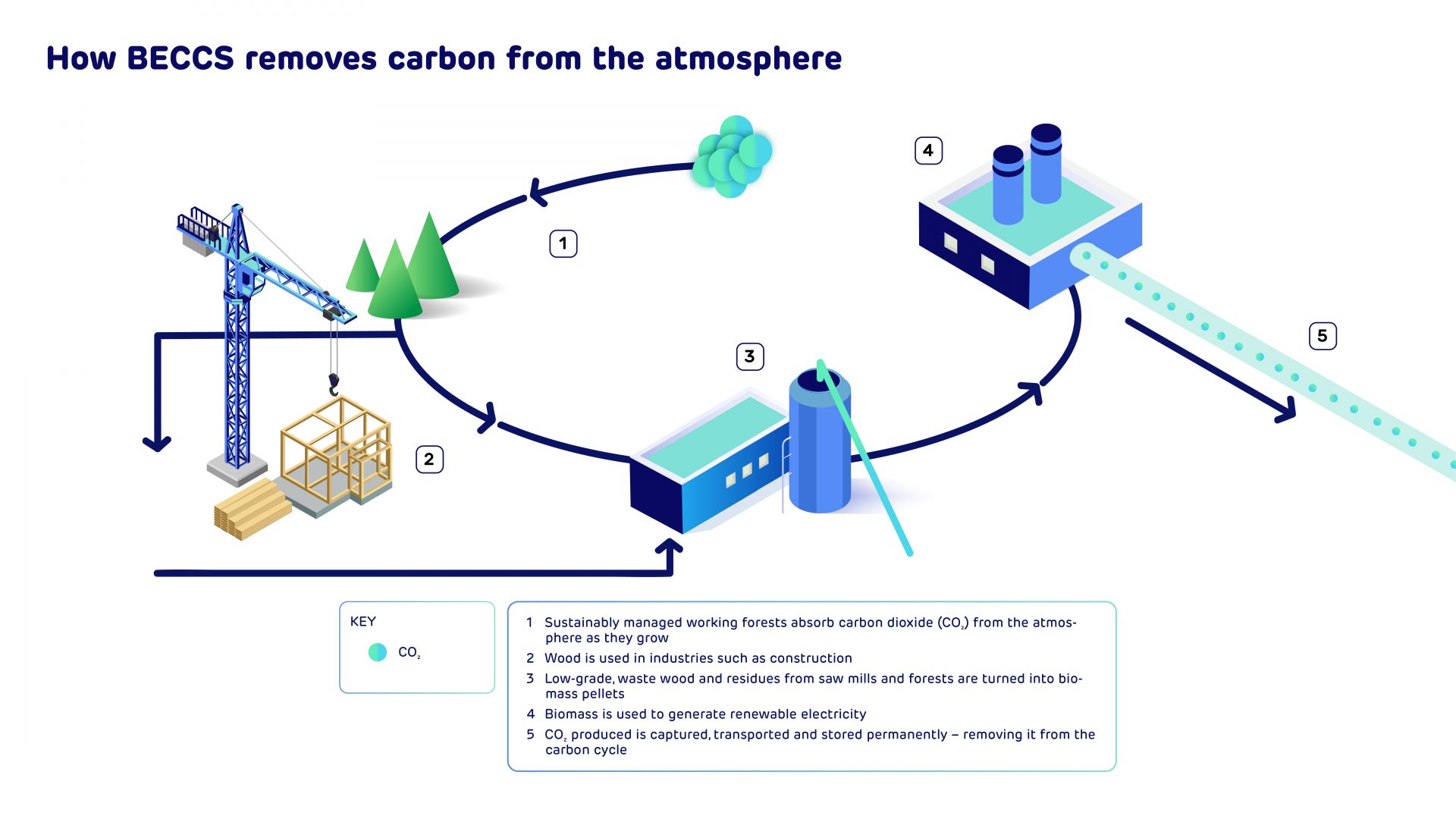
Click graphic to view. Find out more about Bioenergy with carbon capture and storage (BECCS) and negative emissions.
I’m confident the partnership with other leading energy, industrial and academic organisations can act as a revitalising force in a region that has historically been under-invested in, protect 55,000 jobs and create 50,000 new opportunities.
Developing the supply chain surrounding a world-leading zero-carbon cluster in the Humber could deliver a £3.2 billion economic boost to the wider economy as we emerge from the COVID-19 pandemic.
I believe we can establish a new industry to export globally. The Humber’s ports have a long history of trade and we can build on this legacy. The machinery, equipment and services needed to develop BECCS and Zero Carbon Humber will be an essential export as the rest of the world races to decarbonise.
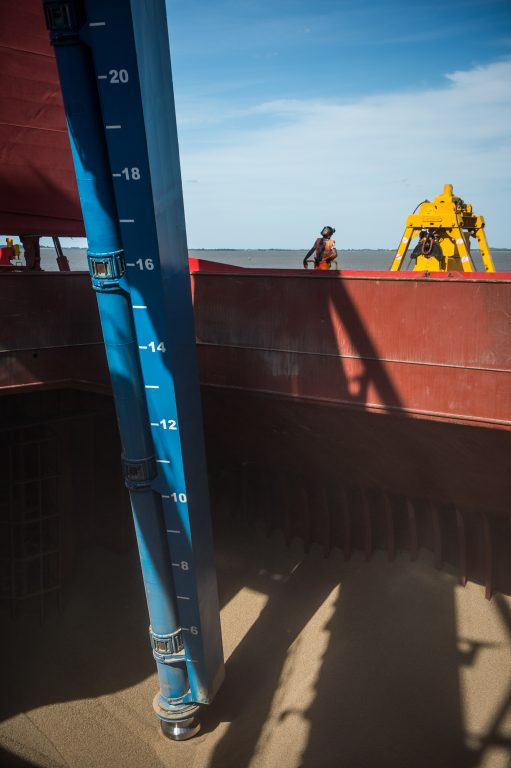
Unloading sustainable biomass wood pellets destined for Drax Power Station from a vessel at the port of Immingham
By providing training and partnering with educational institutions we can increase scientific and technical skills. Net zero industrial clusters can enable more in society the opportunity to have rewarding and fulfilling engineering, energy and environmental careers.
This model can reach around the world – positioning people and businesses to help countries to reach the collective goals of Paris Agreements.
The economic benefits for such achievements far outweigh the costs of failing to stem global warming and we are ready to invest in the technologies needed to do so. With robust government policies in place, a net zero future could cost as little as 1% of GDP over the next 30 years.
Countering climate change is a once-in-a-lifetime challenge for the world, but also a once-in-a-lifetime opportunity to build a sustainable future with sustainable jobs, improved standards of living, health and wellbeing. The UK has a responsibility to use its expertise and resources, setting in place the structures that can allow companies like mine – Drax – to lead the world to reaching the Paris Agreement’s targets and beyond.

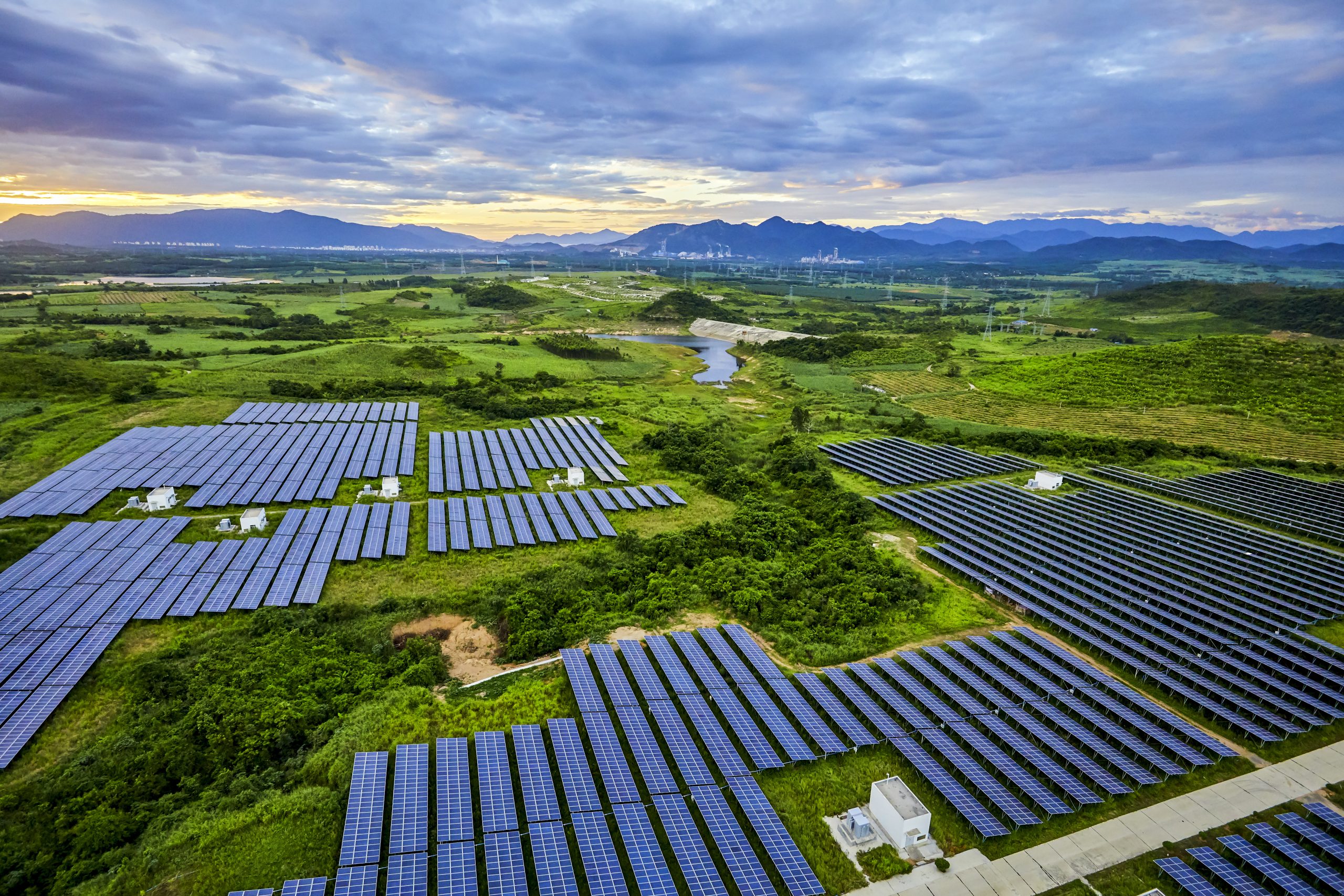
Dear Prime Minister, Chancellor, COP26 President and Minister for Energy and Clean Growth,
We are a group of energy companies investing tens of billions in the coming decade, deploying the low carbon infrastructure the UK will need to get to net zero and drive a green recovery to the COVID-19 crisis.
We welcome the leadership shown on the Ten Point Plan for a Green Industrial Revolution, and the detailed work going on across government to deliver a net zero economy by 2050. We are writing to you to call on the Government to signal what this will mean for UK electricity decarbonisation by committing to a date for a net zero power system.

Head of BECCS Carl Clayton inspects pipes at the CCUS Incubation Area, Drax Power Station
The electricity sector will be the backbone of our net zero economy, and there will be ever increasing periods where Great Britain is powered by only zero carbon generation. To support this, the Electricity System Operator is putting in place the systems, products and services to enable periods of zero emissions electricity system operation by 2025.
Achieving a net zero power system will require government to continue its efforts in key policy areas such as carbon pricing, which has been central in delivering UK leadership in the move away from coal and has led to UK electricity emissions falling by over 63% between 2012 and 2019 alone.
It is thanks to successive governments’ commitment to robust carbon pricing that the UK is now using levels of coal in power generation last seen 250 years ago – before the birth of the steam locomotive. A consistent, robust carbon price has also unlocked long term investment low-carbon power generation such that power generated by renewables overtook fossil fuel power generation for the first time in British history in the first quarter of 2020.
Yet, even with the demise of coal and the progress in offshore wind, more needs to be done to drive the remaining emissions from electricity as its use is extended across the economy.
In the near-term, in combination with other policies, continued robust carbon pricing on electricity will incentivise the continued deployment of low carbon generation, market dispatch of upcoming gas-fired generation with Carbon Capture and Storage (CCS) projects and the blending of low carbon hydrogen with gas-fired generation. Further forward, a robust carbon price can incentivise 100% hydrogen use in gas-fired generation, and importantly drive negative emissions to facilitate the delivery of a net zero economy.
Next year, the world’s attention will focus on Glasgow and negotiations crucial to achieving our climate change targets, with important commitments already made by China, the EU, Japan and South Korea amongst others. An ambitious 2030 target from the UK will help kickstart the Sprint to Glasgow ahead of the UK-UN Climate Summit on 12 December.
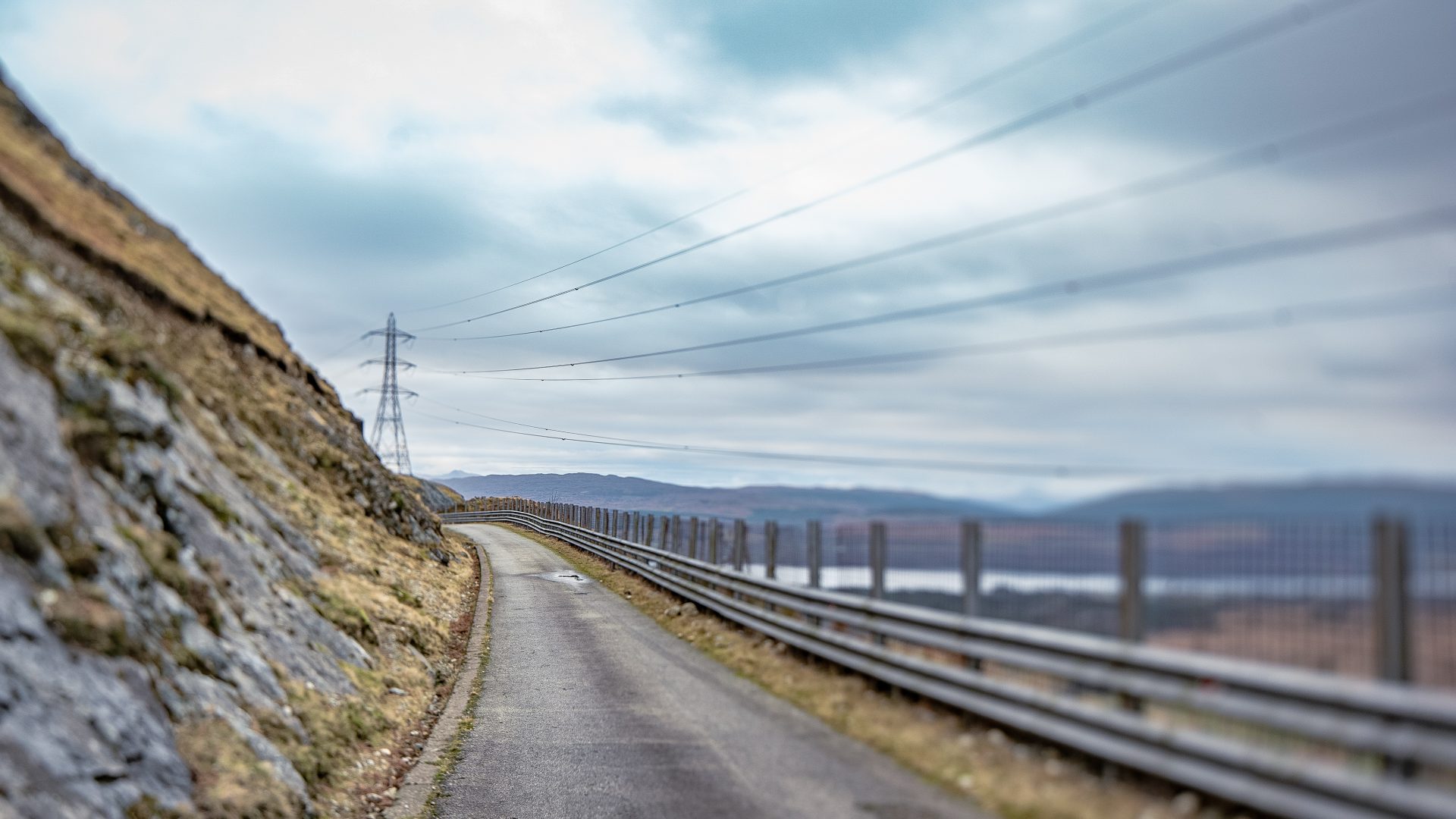
Electricity cables and pylon snaking around a mountain near Cruachan Power Station, Drax’s flexible pumped storage facility in the Highlands
2030 ambition is clearly needed, but to deliver on net zero, deep decarbonisation will be required. Previous commitments from the UK on its coal phase out and being the first major economy to adopt a net zero target continue to encourage similar international actions. To build on these and continue UK leadership on electricity sector decarbonisation, we call on the UK to commit to a date for a net zero power system ahead of COP26, to match the commitment of the US President-elect’s Clean Energy Plan. To ensure the maximum benefit at lowest cost, the chosen date should be informed by analysis and consider broad stakeholder input.
Alongside near-term stability as the UK’s carbon pricing future is determined, to meet this commitment Government should launch a consultation on a date for a net zero power system by the Budget next year, with a target date to be confirmed in the UK’s upcoming Net Zero Strategy. This commitment would send a signal to the rest of the world that the UK intends to maintain its leadership position on climate and to build a greener, more resilient economy.
To:
Signatories:
BP, Drax, National Grid ESO, Sembcorp, Shell and SSE
View/download letter in PDF format

For the UK to reach net zero CO2 emissions by 2050 and do its part in tackling the biggest challenge of our time, all sectors of the economy must reduce their emissions and do it quickly.
I believe the best approach to tackling climate change is through ‘co-benefit’ solutions: solutions that not only have a positive environmental impact, but that are economically progressive for society today and in the future through training, skills and job creation.
As an energy company, this task is especially important for Drax. We have a responsibility to future generations to innovate and use our engineering skills to deliver power that’s renewable, sustainable and that doesn’t come at a cost to the environment.
Our work on Zero Carbon Humber, in partnership with 11 other forward-thinking organisations, aims to deploy the negative emissions technology BECCS (bioenergy with carbon capture and storage), as well as CCUS (carbon capture, usage and storage) in industry and power, and ramp up hydrogen production as a low carbon fuel. These are all essential technologies in bringing the UK to net zero, but they are also innovative projects at scale that can benefit society and the lives of people in the Humber, and around the UK.
The Humber region has a proud history in heavy industries. What began as a thriving ship building hub has evolved to include chemicals, refining and steel manufacturing. However, these emissions-intensive industries have grown increasingly expensive to operate and many have left for countries where they can be run cheaper, leading to a decline in the Humber region.
If they are not decarbonised, these industries will face an even greater cost. By 2040, emitters could face billions of pounds per year in carbon taxes, making them less competitive and less attractive for international investment.
Deploying carbon capture and hydrogen are essential steps towards modernising these businesses and protecting up to 55,000 manufacturing and engineering jobs in the region.
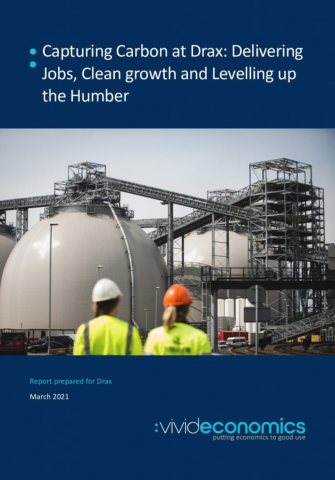
Capturing carbon at Drax: Delivering jobs, clean growth and levelling up the Humber. Click to view executive summary and case studies from Vivid Economics report for Drax.
A report by Vivid Economics commissioned by Drax, found that carbon capture and hydrogen in the Humber could create and support almost 48,000 new jobs at the peak of the construction period in 2027 and provide thousands of long term, skilled jobs in the following decades.
As well as protecting people’s livelihoods, decarbonisation is also a matter of public health. In the Humber alone, higher air quality could save £148 million in avoided public health costs between 2040 and 2050.
I believe the UK is well position to rise to the challenge and lead the world in decarbonisation technology. There is a clear opportunity to export knowledge and skills to other countries embarking on their own decarbonisation journeys. BECCS alone could create many more jobs related to exporting the technology and operational know-how and deliver additional value for the economy. As interest in negative emissions grows around the world, the UK needs to move quickly to secure a competitive advantage.
This is in many ways the start of a new sector in our economy – one that can offer new employment, earnings and economic growth. It comes at just the right time. Without intervention to spur a green recovery, the COVID-19 crisis risks subjecting long-term economic damage.
Being at the beginning of the industrial decarbonisation journey means we also have the power to shape this new industry in a way that spreads the benefits across the whole of the UK.
We’ve previously seen sector deals struck between the government and industry include equality measures. For example, the nuclear industry aims to count women as 40% of its employees by 2030, while offshore wind is committed to sourcing 60% of its supply chain from the UK.
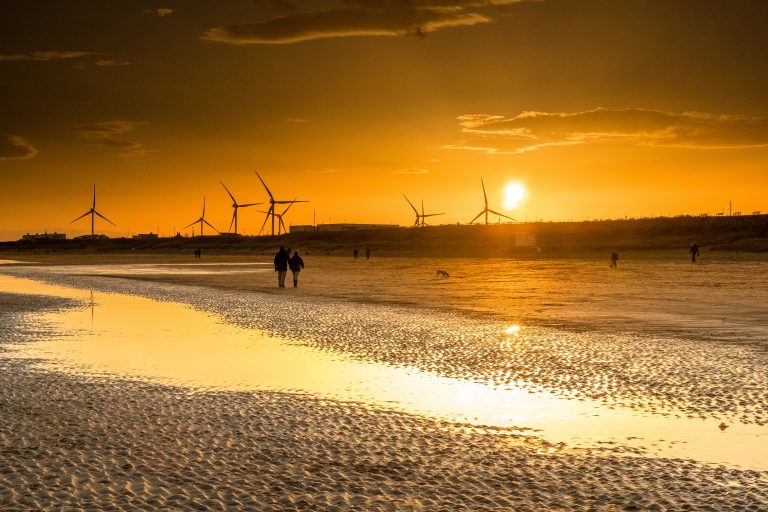
Wind turbines at Bridlington, East Yorkshire
At present, the Humber region receives among the lowest levels of government investment in research and development in the UK, contributing to a pronounced skills gap among the workforce. In addition, almost 60% of construction workers across the wider Yorkshire and Humber region were furloughed as of August 2020.
A project such as Zero Carbon Humber could address this regional imbalance and offer skilled, long term jobs to local communities. That’s why I welcome the Prime Minister’s announcement of £1bn investment to support the establishment of CCUS in the Humber and other ‘SuperPlaces’ around the UK.
As the Government’s Ten Point Plan says, CCUS can ‘help decarbonise our most challenging sectors, provide low carbon power and a pathway to negative emissions’.
The co-benefits of BECCS extend beyond our communities in the UK. We aim to become carbon negative by 2030 by removing our CO2 emissions from the atmosphere and abating emissions that might still exist on the UK’s path to net zero.

This ambition will only be realised if the biomass we use continues to be sourced from sustainable forests that positively benefit the environment and the communities in which we and our suppliers operate.
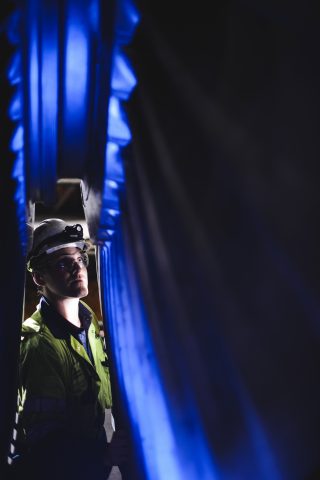
Engineer working in turbine hall, Drax Power Station, North Yorkshire
I believe we must continuously improve our sustainability policy and seek to update it as new findings come to light. We can help ensure the UK’s biomass sourcing is led by the latest science, best practice and transparency, supporting healthy, biodiverse forests around the world; and even apply it internationally.
Delivering deep decarbonisation for the UK will require collaboration from industries, government and society. What we can achieve through large-scale projects like Zero Carbon Humber is more than just the vital issue of reduced emissions. It is also about creating jobs, protecting health and improving livelihoods.
These are more than just benefits, they are the makings of a future filled with opportunity for the Humber and for the UK’s Green Industrial Revolution.
By implementing the Ten Point Plan and publishing its National Determined Contributions (NDCs) ahead of COP26 in Glasgow next year, the UK continues to be an example to the world on climate action.
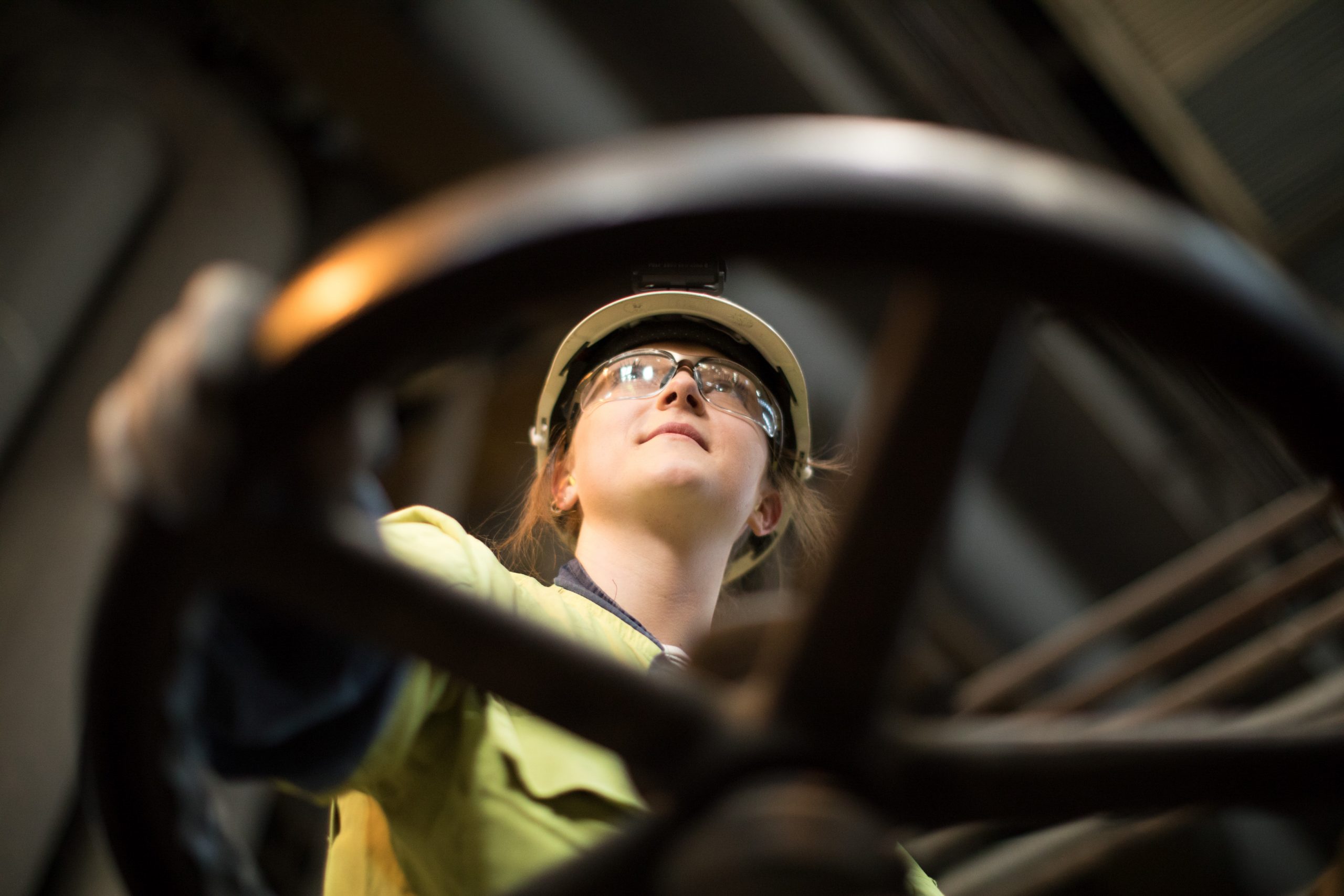
The Humber Estuary is one of the most distinctive features of the UK’s eastern coastline. Viewed from above, it is a crack in the land where the North Sea merges with England – it’s this connection to the sea that has defined it as a region and led to its rich industrial history.
But in recent years, as sectors such as heavy manufacturing move overseas, the Humber has begun to sink into economic decline. These challenges are now being exacerbated by COVID-19 – almost 60% of workers in the Yorkshire and the Humber construction industry were furloughed in August 2020.
Stimulation is needed to rejuvenate the Humber and prevent lasting economic scars on the region and its working-age population. Decarbonisation offers the opportunity to rebuild the region for the 2020s and decades ahead.
Technologies that have been identified as essential for the UK to reach its legally-binding commitment of net zero greenhouse gas emissions by 2050 include:
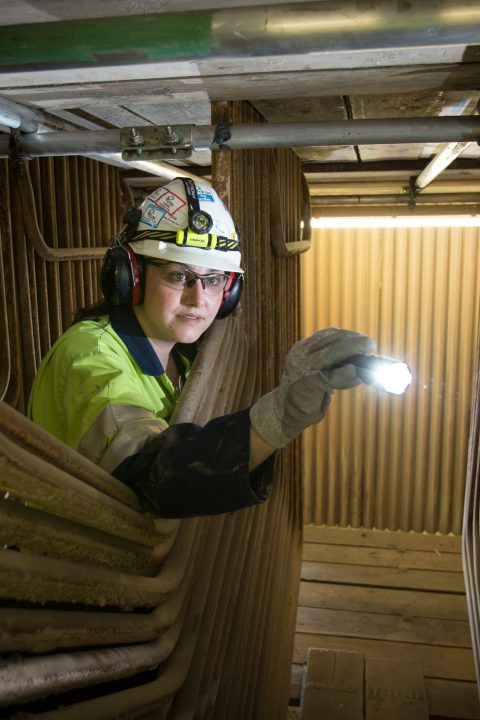 The Humber has unique capabilities that positions it as a hub for developing all three.
The Humber has unique capabilities that positions it as a hub for developing all three.
Zero Carbon Humber (ZCH), the partnership between a number of leading companies (including Drax), aims to bring together these essential technologies and create the foundations from which the region’s emissions-heavy industries can regain their competitive edge, create jobs and rejuvenate the area.
A new report by Vivid Economics for Drax investigates the potential economic impact of carbon capture and hydrogen. It concluded that nearly 48,000 jobs could be created and supported in the industrial cluster at the peak of the construction phase in 2027.
It’s a chance to not just revitalise a powerhouse of Northern England, but to collaborate with other industrial clusters and build a UK-wide green economy ready to export globally and attract international business to the region.
The North Sea has helped forge Hull’s strong industrial heritage of ship building and fishing. In the 1950s the flat lands of the south bank enabled post-war industries such as refining chemicals and steel to thrive.
“The region’s economy is built around the ports and accessibility to Europe and the North Sea,” explains Pauline Wade, Director of International Trade at the Hull and Humber Chamber of Commerce. “They are the biggest ports in the UK in terms of tonnage, and the energy and chemical industries hinge on materials coming in and going out of them.”
But these are also emissions-intensive industries, and as a result the Humber has the highest CO2 emissions of any UK industrial region – emitting 30% more than the second largest industrial cluster. Decarbonisation is vital in modernising and protecting these sectors, and the 55,000 manufacturing jobs they support.
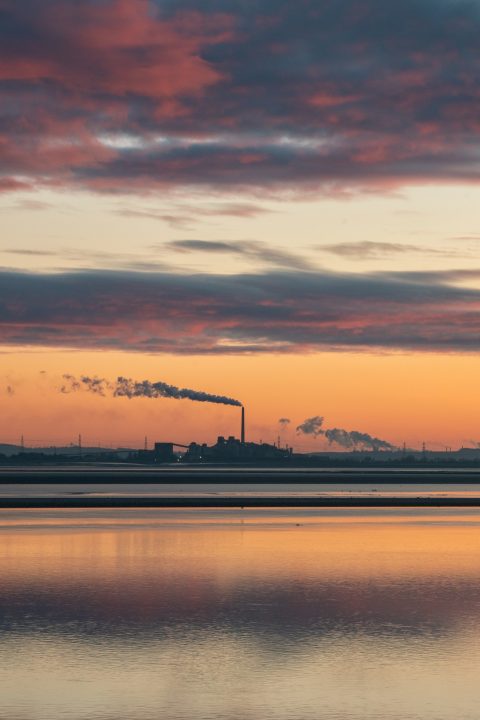
“Decarbonisation brings opportunities. Many businesses in this region have that target very firmly set in their business plans,” says Beckie Hart, Regional Director of the Yorkshire and the Humber CBI (Confederation of British Industry). “Many are high polluters – they know that, but they are very keen to became part of the solution.”
Developing BECCS, CCUS and hydrogen, as well as building the infrastructure needed to capture and transport CO2, offers both immediate construction jobs and long-term skilled jobs.
The main construction period of the project would run from 2024 to 2031 and support up to 47,800 new jobs at its peak in 2027, when £3.1 billion a year would be added to the regional economy. These include up to 25,200 high quality jobs in construction and operations, as well as a further 24,400 supported across the supply chain and wider economy.
These construction roles include jobs such as welders, pipe fitters, machine installers and technicians – with immediate government backing, these jobs could be available in as little as four years. Ongoing operations will also create 3,300 long term, skilled jobs in the cluster in the early 2030s.
The supply chain needed to provide the materials and parts for the region’s industrial revitalisation will also support further indirect jobs. In fact, businesses of all kinds stand to benefit – the increased spending by workers also could support further jobs across businesses ranging from cafes to professional services. These indirect jobs go on to induce further employment and spending out across more of the economy.
Overall the report suggests an annual average of more than 7,000 indirect and around 10,800 induced jobs could be supported during the construction phase, with £452 million in indirect and £581 million in induced value added to the wider economy annually on average.
However, transformation is costly and today the Humber region receives among the lowest levels of government investment in research and development in the UK. This has contributed to a pronounced skills gap in the region, as opportunities decline, and more people fall out of the workforce.
Projects such as ZCH depend on availability of skilled workforces to build and operate the next generation of energy technologies. However, the Humber currently has a low proportion of school leavers with the right qualifications to take on roles with specialist technical and practical skills.
This skills gap is only expected to get worse. The Government’s Working Futures model forecasts that from 2022 key sectors such as electricity and gas, engineering and construction in the region will require higher qualifications than are currently available in the local labour market.
The skills gap is also compounded by COVID-19. As it creates economic uncertainty it pushes more people out of work and further reduces skills in the workforce. This has a particularly pronounced impact on young people who are less established in careers, threatening to create a ‘COVID-Generation’ that feel discouraged and detached from the labour market.
But this is not an inevitability.
With the right intervention from government and business, the Humber’s workforce can be upskilled and drive a green recovery.
A number of different approaches are possible: apprenticeships have historically proved a valuable means of training the next generation of workers. Companies and schools should work together to highlight the opportunities of vocational training to school leavers.
“Universities and colleges must work a lot more closely with the businesses in the region to have an honest conversation about what they need,” explains Hart. “A good example is the Ron Dearing University Technical College. It’s a business-led college that has only been open about 18 months but has had great results from the students because they offer specific courses that the region’s employers actually need.”
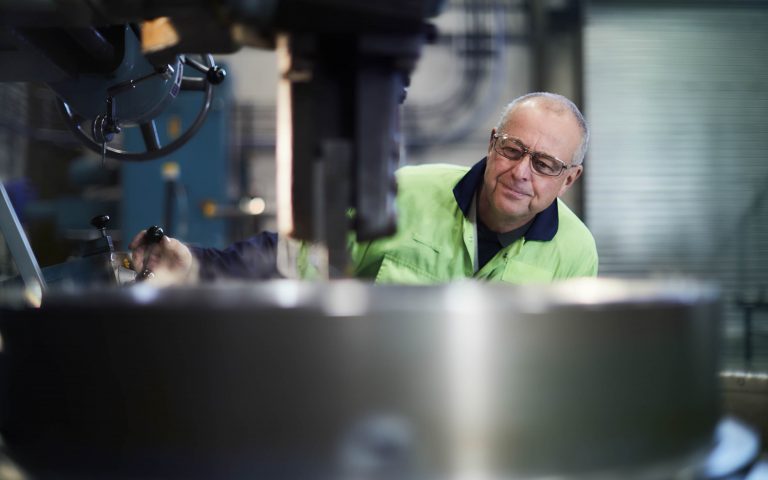
For older generations of workers who have been out of the labour force for extended periods of time ‘skills vouchers’ are a timely intervention. These work by offering grants to cover the cost of flexibly retraining, meaning long-term unemployed workers of any age can ease back into new types of jobs.
Training local people for the future is key to decarbonising the Humber and creating jobs, as well as protecting industries. But a net zero industrial cluster could also have an impact beyond just the Humber.
The Committee on Climate Change (CCC) has made it clear that for the UK to reach net zero by 2050 CCUS and negative emissions from BECCS are essential, as is hydrogen as a zero-carbon source of fuel. These will be needed at scale across the UK, and in the Humber. They are already underway.
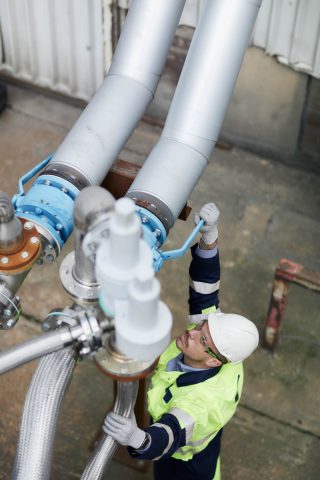
Engineer at BECCS pilot project within Drax Power Station
Drax Power Station is piloting BECCS technology and has proven it can deliver negative emissions. Generating electricity using biomass from sustainably managed forests that absorb CO2 is a carbon neutral process. As part of the power generation process, adding CCUS and capturing the CO2 emitted, storing it permanently under the North Sea turns the process into a carbon negative one.
Deploying BECCS across four of Drax’s generating units would support 10,304 jobs and create £673 million in value at the peak of the construction phase. When operations get underway as early as 2027, 750 permanent operations and maintenance jobs could be created. Drax aims to operate as a carbon negative power station by 2030.
Of the 10,491 jobs supported by deploying BECCS (10,300 at the peak), 6,367 of these would be within the project’s supply chain and wider economy (9,073 in 2028).
Such supply chains needed across the North of England offer further potential to establish Yorkshire and the Humber as a hub for decarbonisation technology.
Facilities such as an Advanced Manufacturing Research Centre (AMRC) have been proven to make regions of the UK more competitive locations for advanced industries. By bringing together business with universities, they can focus on sector-specific challenges for technical industries. By creating a manufacturing hub dedicated to research and innovation in a specific industry, AMRCs also encourage ‘crowing-in investments.’ This is when private sectors investments enter into a region in the wake of government spending.
A zero carbon technology-focused AMRC in the Humber would also position the region to offer decarbonisation skills and products to other industrial clusters in the UK and further afield.
Up the north coast from the Humber is Net Zero Teesside, a neighbouring industrial cluster with its own aims for decarbonisation. Through collaboration with clusters such as this, ZCH can offer even wider reaching benefits and enable UK-wide carbon capture, negative emissions and hydrogen.
However, for the entire UK to reach net zero, clusters all across the country must decarbonise – the report suggests as much as 190 million tonnes (Mt) CO2 could be captured and stored every year across the country.
Beyond just the clusters themselves 193,000 jobs could be created at the peak for UK deployment in 2039. These jobs would add £13.9 billion in value to the economy.

Building a strong zero carbon economy based around the combined strengths of BECCS, CCUS and hydrogen can provide the UK with a world-leading export. At a time when countries across the globe all face the same decarbonisation challenges, successfully building clusters like ZCH will allow the UK to export knowledge, skilled labour, technology and services around the world.
“As a port city, Hull has always had an international influence. The chamber of commerce was set up in 1837 by the merchant adventurers who were seafaring traders. That history is inbuilt into the local DNA,” says Wade. “Today, we’re trying to create the environment for international companies to invest and locate in the Humber.”
It serves as a further example of how investing decisively in projects such as Carbon Capture by Drax and CCUS and hydrogen clusters such as Zero Carbon Humber today will bring long term economic benefits, taking the UK from a green recovery to a world-leading green industrial powerhouse.
“The Humber has evolved from the fishing industry to a generator of high-emissions products like steel, chemicals and power,” explains Hart. “Now it is keen to be the clean corner and teach everyone else how to decarbonise. There is a single vision of where we want to go and how they want to get there jointly.”
Read the full report (PDF), executive summary and press release.


To tackle the climate crisis, global unity and collaboration are needed. This was in part the thinking behind the Paris Agreement. It set a clear, collective target negotiated at the 2015 United Nations Climate Change Conference and signed the following year: to keep the increase in global average temperatures to well below 2 degrees Celsius above pre-industrial levels.
In November 2021, COP26 will see many of the countries who first signed the Paris Agreement come together in Glasgow for the first ‘global stocktake’ of their environmental progress since its creation.
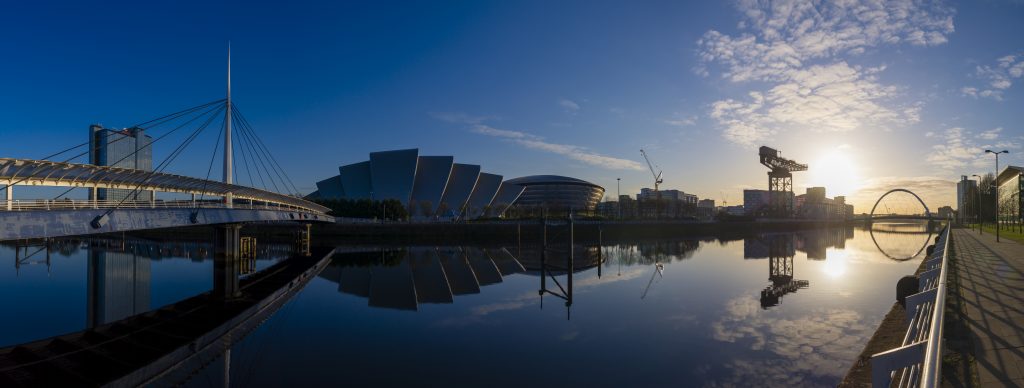
COP26 will take place at the SEC in Glasgow
Already delayed for a year as a result of the pandemic, COVID-19 and its effects on emissions is likely to be a key talking point. So too will progress towards not just the Paris Agreement goals but those of individual countries. Known as ‘National Determined Contributions’ (NDCs), these sit under the umbrella of the Paris Agreement goals and set out individual targets for individual countries.
With many countries still reeling from the effects of COVID-19, the question is: which countries are actually on track to meet them?
The NDCs of each country represent its efforts and goals to reduce national emissions and adapt to the impacts of climate change. These incorporate various targets, from decarbonisation and forestry to coastal preservation and financial aims.
While all countries need to reduce emissions to meet the Paris Agreement targets, not all have an equally sized task. The principle of differentiated responsibility acknowledges that countries have varying levels of emissions, capabilities and economic conditions.
The Universal Ecological Fund outlined the emissions breakdown of the top four emitters, showing that combined, they account for 56% of global greenhouse gas emissions. China is the largest emitter, responsible for 26.8%, followed by the US which contributes 13.1%. The European Union and its 28 member states account for nine per cent, while India is responsible for seven per cent of all emissions.
These nations have ambitious emissions goals, but are they on track to meet them?

Traffic jams in the rush hour in Shanghai Downtown, contribute to high emissions in China.
By 2030, China pledged to reach peak carbon dioxide (CO2), increase its non-fossil fuel share of energy supply to 20% and reduce the carbon intensity – the ratio between emissions of CO2 to the output of the economy – by 60% to 65% below 2005 levels.
COVID-19 has increased the uncertainty of the course of China’s emissions. Some projections show that emissions are likely to grow in the short term, before peaking and levelling out sometime between 2021 and 2025. However, according to the Climate Action Tracker it is also possible that China’s emissions have already peaked – specifically in 2019. China is expected to meet its non-fossil energy supply and carbon intensity pledges.
The forecast for the second largest emitter, the US, has also been affected by the pandemic. Economic firm Rhodium Group has predicted that the US could see its emissions drop between 20% and 27% by 2025, meeting its target of reducing emissions by 26% to 28% below 2005 levels.
However, President Trump’s rolling back of Obama-era climate policies and regulations, his support of fossil fuels and withdrawal from the Paris Agreement (effective from as early as 4 November 2020), suggest any achievement may not be long-lasting.
The United States’ Coronavirus Aid, Relief, and Economic Security Act, known as the CARES Act, does not include any direct support to clean energy development – something that could also change in 2021.
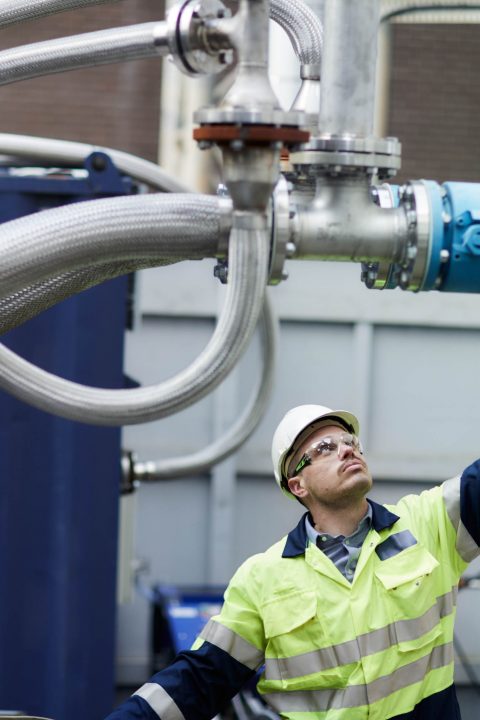
Carl Clayton, Head of BECCS at Drax, inspects pipework in the CCUS area of Drax Power Station
The European Union and its member states, then including the UK, pledged to reduce emissions by at least 40% below 1990 levels by 2030 – a target the Climate Action Tracker estimates will be achieved. In fact, the EU is on track to cut emissions by 58% by 2030.
This progress is in part a result of a large package of measures adopted in 2018. These accelerated the emissions reductions, including national coal phase-out plans, increasing renewable energy and energy efficiency. The package also introduced legally binding annual emission limits for each member state within which they can set individual targets to meet the common goal.
The UK has not yet released an updated, independent NDC. However, it has announced a £350 million package designed to cut emissions in heavy industry and drive economic recovery from COVID-19. This includes £139 million earmarked to scale up hydrogen production, as well as carbon capture and storage (CCS) technology, such as bioenergy with carbon capture (BECCS) – essential technologies in achieving net zero emissions by 2050 and protecting industrial regions.
India, the fourth largest global emitter, is set to meet its pledge to reduce its emissions intensity by 33% to 35% below 2005 levels and increase the non-fossil share of power generation to 40% by 2030. What’s more, the Central Electricity Agency has reported that 64% of India’s power could come from non-fossil fuel sources by 2030.
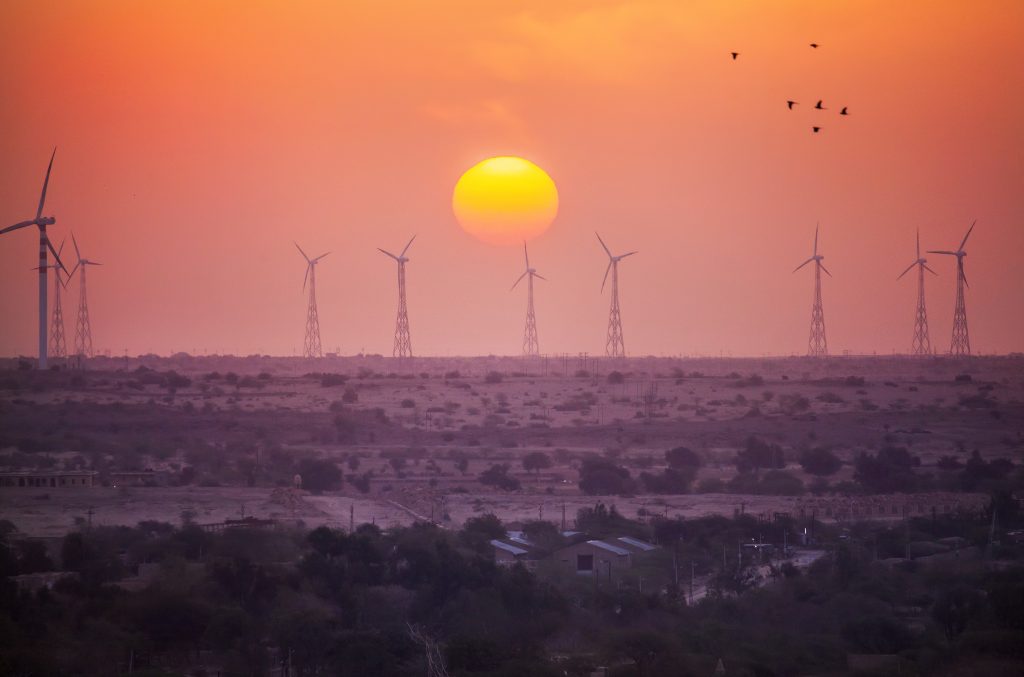
Wind turbines in Jaisalmer, Rajasthan, India
Along with increasingly renewable generation, the implementation of India’s National Smart Grid Mission aims to modernise and improve the efficiency of the country’s energy system.
It is promising that the world’s four largest emitters have plans in place and are making progress towards their decarbonisation goals. However, tackling climate change requires action from around the entire globe. In addition to NDCs, many countries have committed to, or have submitted statements of intent, to achieve net zero carbon emissions in the coming years.
| Country | Target Date | Status |
|---|---|---|
| Bhutan 🇧🇹 | Currently carbon negative (and aiming for carbon neutrality as it develops; pledged towards the Paris Agreement) | |
| Suriname 🇸🇷 | Currently carbon negative | |
| Denmark 🇩🇰 | 2050 | In law |
| France 🇫🇷 | 2050 | In law |
| Germany 🇩🇪 | 2050 | In law |
| Hungary 🇭🇺 | 2050 | In law |
| New Zealand 🇳🇿 | 2050 | In law |
| Scotland 🏴 | 2045 | In law |
| Sweden 🇸🇪 | 2045 | In law |
| United Kingdom 🇬🇧 | 2050 | In law |
| Bulgaria 🇧🇬 | 2050 | Policy Position |
| Canada 🇨🇦 | 2050 | Policy Position |
| Chile 🇨🇱 | 2050 | In policy |
| China 🇨🇳 | 2060 | Statement of intent |
| Costa Rica 🇨🇷 | 2050 | Submitted to the UN |
| EU 🇪🇺 | 2050 | Submitted to the UN |
| Fiji 🇫🇯 | 2050 | Submitted to the UN |
| Finland 🇫🇮 | 2035 | Coalition agreement |
| Iceland 🇮🇸 | 2040 | Policy Position |
| Ireland 🇮🇪 | 2050 | Coalition Agreement |
| Japan 🇯🇵 | 2050 | Policy Position |
| Marshall Islands 🇲🇭 | 2050 | Pledged towards the Paris Agreement |
| Netherlands 🇳🇱 | 2050 | Policy Position |
| Norway 🇳🇴 | 2050 in law, 2030 signal of intent | |
| Portugal 🇵🇹 | 2050 | Policy Position |
| Singapore 🇸🇬 | As soon as viable in the second half of the century | Submitted to the UN |
| Slovakia 🇸🇰 | 2050 | Policy Position |
| South Africa 🇿🇦 | 2050 | Policy Position |
| South Korea 🇰🇷 | 2050 | Policy Position |
| Spain 🇪🇸 | 2050 | Draft Law |
| Switzerland 🇨🇭 | 2050 | Policy Position |
| Uruguay 🇺🇾 | 2030 | Contribution to the Paris Agreement |
While the COVID-19 pandemic has disrupted short-term plans, many see it as an opportunity to rejuvenate economies with sustainability in mind. COP26, as well as the global climate summit planned for December of this year, will likely see many countries lay out decarbonisation goals that benefit both people’s lives and the planet.
#COP26, as well as the UK/UN climate meeting planned for this December, will likely see many countries lay out decarbonisation goals that benefit both people’s lives and the planet. #COP26countdown ⏰ #COP26Ambition 🌍
— Drax (@DraxGroup) October 30, 2020